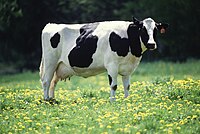
Photo from wikipedia
Male non-replacement calves in dairy systems represent an underutilized economic resource for dairy producers worldwide. Despite this, increasing the practice of rearing non-replacement male calves has significant barriers both in… Click to show full abstract
Male non-replacement calves in dairy systems represent an underutilized economic resource for dairy producers worldwide. Despite this, increasing the practice of rearing non-replacement male calves has significant barriers both in on-farm adoption and practice. Poor neonatal rearing practices, higher levels of morbidity and mortality, and disaggregated production pathways with multiple points of handling, have all been described as barriers to adoption of surplus calf production. To identify the critical decision-determining challenges associated with broader adoption of raising non-replacement stock, and to investigate the whole-of-value chain issues faced by dairy producers to rear non-replacement male calves, we undertook a series of semi-structured interviews with Australian dairy producers to interrogate their key challenges. To achieve this, a constructivist grounded theory approach was used to inform the process of analysis of in-depth interviews with Australian dairy producers regarding their current practices and perceptions. Five major themes emerged from these conversations that were key barriers to on-farm non-replacement calf rearing in the producer group participants. These were: impacts of drought on cost and availability of feed for these calves and the whole herd; the management requirements of non-replacement male calves as an additional workload to that of their current operation; their attitudes and current practices to and surrounding euthanasia; perceived ease of supply-chain access for these calves, and their perceptions of the economic value of dairy-beef product as a return on investment. Understanding the barriers to adoption of non-replacement calf rearing, and addressing the value proposition for dairy beef, can assist increased uptake of non-replacement calf rearing. These findings will allow development of strategies to address these barriers, and extension of viable management strategies to increase adoption of profitable business practices surrounding non-replacement male calf production.
Journal Title: Frontiers in Veterinary Science
Year Published: 2021
Link to full text (if available)
Share on Social Media: Sign Up to like & get
recommendations!